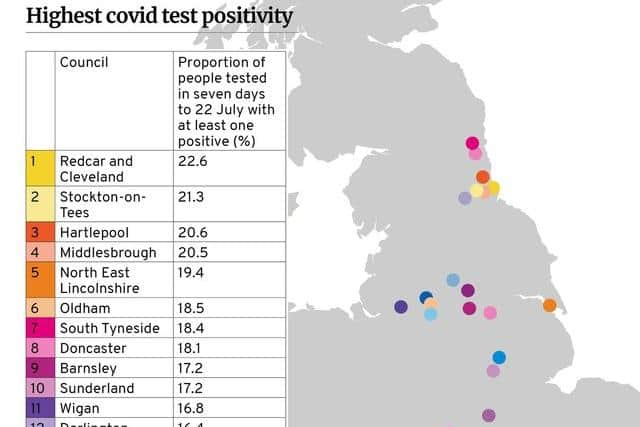Covid positivity rate: proportion of people testing positive in Doncaster falls but far exceeds WHO 5% limit
and live on Freeview channel 276
The drop in coronavirus cases has prompted optimism that the current wave of infection has peaked, but that downward trend in England ended on Wednesday (28 July)
And even as cases were coming down in recent days many people were asking 'are there really fewer cases or are fewer tests being done?’
Advertisement
Hide AdAdvertisement
Hide AdOf the people who took a polymerase chain reaction (PCR) test in Doncaster in the seven days to 23 July, 16.9% had at least one positive result, with duplicate positives for the same people removed.


That is down from 18.3% in the week to 16 July.
Last year WHO recommended that governments should ensure the proportion of coronavirus tests coming back positive remains below 5% for at least two weeks before regions reopen.
The threshold is the maximum limit at which point a pandemic would be considered out of control, although positivity rates would ideally be far lower.
Doncaster’s positivity rate places it eighth highest out of 315 councils in England.
Advertisement
Hide AdAdvertisement
Hide AdThe figures also show the number of people taking tests in Doncaster fell by 14.4 % in the last seven days compared to the previous week, from 14857 to 12713 a fall of 2144.
The number of positive cases – including those from lateral flow devices as well as PCR tests fell by 22.9 % - 620 – over the same period, from 2703 to 2083.
Across the country, just one council (Somerset West and Taunton) has a rate lower than the WHO’s threshold, while one (Breckland, in Norfolk) is at 5%.
England’s rate stood at 10.2% in the week to 23 July.
The overall number of cases fell by 21.9% in that time, from 289,000 to 226,000. The number of people tested fell by 11.6%, from 2.6 million to 2.3 million.
Advertisement
Hide AdAdvertisement
Hide AdThe highest rate is in the North East (15.2%) followed by Yorkshire and the Humber (13.5%) and the West Midlands (11.8%).
England’s positivity rate has climbed rapidly throughout June and July. In the seven days to 25 June it stood at 4%, rising to 6.1% in the week to 2 July and 7.8% in the week to 9 July.
The rate has fallen since reaching a peak of 11.8% in the seven days to 19 and 20 July, falling for three consecutive days since, although fluctuations in testing on different days of the week can always affect comparisons.
Figures released on Wednesday (28 July) show the number of cases reported in the last 24 hours – regardless of when the test was taken – rose to 27,734, up from 23,511 on Tuesday, and the first daily increase for seven days.
Advertisement
Hide AdAdvertisement
Hide AdOverall, 87 out of 315 councils saw a rise in their positivity rate in the last week – 65 of which saw a simultaneous drop in recorded cases.
WHO set out its 5% threshold in May last year, long before effective vaccines had been developed and rolled out.The positivity rate threshold should be used to supplement estimates of the R-number
– the rate of the virus’s transmission in communities – to assess whether the epidemic is under control, it said.